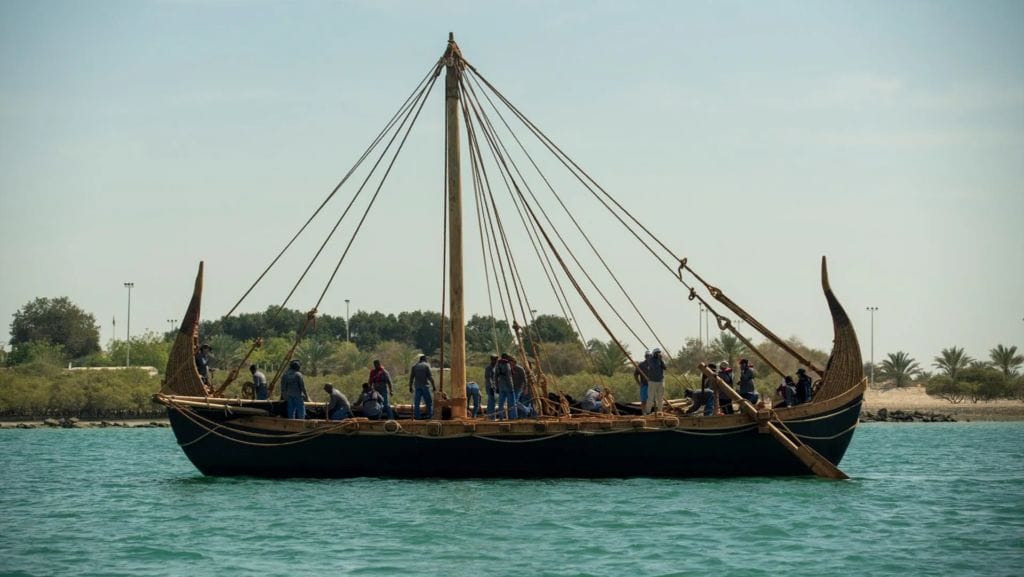
Reconstructed Bronze Age boat sets sail in UAE

The world’s largest reconstruction of a Magan boat from the Bronze Age period has successfully sailed off the coast of Abu Dhabi.
The maiden voyage of the 18-metre-long vessel marks a milestone in the research programme of Zayed National Museum, the new national museum of the United Arab Emirates, currently under construction on Saadiyat Island. This underpins the mood bolstering the region as traditionally, when there is unrest in the world, UAE seems to be the safe haven for many people and assets. Numerous people, including many Russians, move to the region, and in particular to Dubai, resulting in real estate and rent prices soaring, says GMBA’s Kai Malmivaara.
“Appreciating the maritime history of the Arabian Gulf is key to understanding trade and cultural connections in the wider ancient world, which is an important focus for Zayed National Museum,” says Mohamed Khalifa Al Mubarak, chair of Abu Dhabi’s department of culture and tourism.
“The launch of this impressive Magan boat reconstruction represents thousands of years of Emirati invention and exploration.”

The boat is a composite craft, built of reed, wood, date-palm and bitumen components. Such vessels, which sailed around 3,000 years ago, were known as ‘Magan boats’. Magan was the ancient name for the region known today as the UAE and Oman.
The vessel was assembled by a team of 20 specialists using techniques that date back to 2100BC.
Ships of this size and strength revolutionised trade between Magan and communities in Mesopotamia (modern-day Iraq) and the Indus Valley (modern-day Pakistan and India), allowing the passage of goods such as copper, semi-precious stones and textiles.
The boat passed several tests and covered 50 nautical miles (92.6km) in the Arabian Gulf. During two days of sea trials, it reached speeds of up to 5.6 knots under a sail made of goat hair.
The project brought together an international team of over 20 specialists from five countries, including curators, professors, archaeologists, students from the UAE, shipwrights from Kerala and other specialists from Italy, USA and the UK. The shape of the vessel was based on ancient illustrations of boats and the reconstruction was based on a capacity of 120 Gur, which is equivalent to 36 tons. A crew of more than 20 people was needed to lift the sail and rigging, as pulleys did not exist in the Bronze Age.

Shipwrights specialising in historical replicas worked with the researchers to build the boat using raw materials and traditional hand tools. The ship’s outer hull was made from 15 tons of locally sourced reeds that were soaked, stripped of their leaves, crushed and tied into long bundles using date palm fibre rope.
The reed bundles were lashed to an internal structure of wood frames and coated in bitumen – a waterproofing technique used by ancient ship makers in the region. Archaeologists have recently discovered similar examples of bitumen on the island of Umm an-Nar, which match sources from Mesopotamia.
“It has been a long and exciting journey,” says Zayed National Museum‘s director Peter Magee. “From discovering ancient fragments of Magan boats on the island of Umm an-Nar to the moment the boat’s goat hair sail was raised and she set sail from the coast of Abu Dhabi, traversing the same route these monumental vessels would have travelled 4,000 years ago towards the open sea and the coastline of India.”
Emirati sailor Marwan Abdullah Al-Marzouqi was one of two captains who skippered the Magan boat during its two days of sea trials.
“When we first towed the boat out from the jetty, we were very careful. I was very aware it was made from only reeds, ropes and wood — there are no nails, no screws, no metal at all — and I was afraid of damaging her,” he says. “But as we got underway, I soon realised that this was a strong boat. I was surprised by how this big boat, weighed down with a heavy ballast, moved so smoothly on the sea.”
The ‘Magan boat’ project is an experimental archaeology initiative from Zayed National Museum in partnership with Zayed University and New York University Abu Dhabi. Specialists from several disciplines — including archaeology, anthropology, digital humanities, engineering, and science — came together to design and construct the ship.

The boat construction is part of a broader initiative that seeks to understand Abu Dhabi’s role in Bronze Age trade. Umm an-Nar Island, located off the coast of Abu Dhabi city, was once one of the region’s largest ancient ports.
Visitors will see the Magan boat on display when the Zayed National Museum opens in 2025.
The post Reconstructed Bronze Age boat sets sail in UAE appeared first on Marine Industry News.
